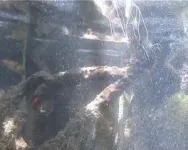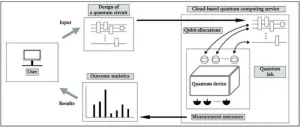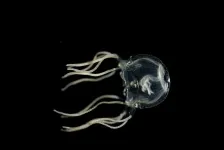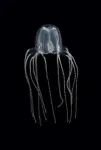(Press-News.org)
Glass, despite its apparent transparency and rigidity, is a complex and intriguing material. When a liquid is cooled to form a glass, its dynamics slows down significantly, resulting in its unique properties.
This process, known as “glass transition”, has puzzled scientists for decades. But one of its intriguing aspects is the emergence of "dynamical heterogeneities," where the dynamics become increasingly correlated and intermittent as the liquid cools down and approaches the glass transition temperature.
In a new study, researchers propose a new theoretical framework to explain these dynamical heterogeneities in glass-forming liquids. The idea is that relaxation in these liquids occurs through local rearrangements, which influence each other via elastic interactions. By investigating the interplay between local rearrangements, elastic interactions, and thermal fluctuations, the researchers have formulated a comprehensive theory for the collective dynamics of these complex systems.
The study is a collaboration between Professor Matthieu Wyart at EPFL and his colleagues at Max Planck Institute in Dresden, the ENS, the Université Grenoble Alpes, and the Center for Systems Biology Dresden. It is now published in Physical Review X.
The team developed a “scaling theory” that explains the growth of the dynamical correlation length observed in glass-forming liquids. This correlation length is linked to "thermal avalanches”, which are rare events induced by thermal fluctuations, which then trigger a subsequent burst of faster dynamics.
The study's theoretical framework also provides insights into the Stoke-Einstein breakdown, a phenomenon where the viscosity of the liquid becomes uncoupled from the diffusion of its particles.
To validate their theoretical predictions, the researchers conducted extensive numerical simulations in various conditions. These simulations supported the accuracy of their scaling theory and its ability to describe the observed dynamics in glass-forming liquids.
The study not only deepens our understanding of glass dynamics but also suggests a new handle to tackle the properties of some other complex systems where the dynamics is intermittent and jerky- features known to occur in a range of situations, from the brain's activity or the sliding between frictional objects.
“Our work connects the growth of the dynamical correlation length in liquids to avalanche-type relaxations, well studied, for example, in the context of disordered magnets, granular materials, and earthquakes,” says Matthieu Wyart. “As such, this approach builds unexpected bridges between other fields. Our description of how avalanches are affected by exogeneous fluctuations, including thermal ones, may thus be of more general interest.”
Reference
Ali Tahaei, Giulio Biroli, Misaki Ozawa, Marko Popović, Matthieu Wyart. Scaling description of dynamical heterogeneity and avalanches of relaxation in glass-forming liquids. Physical Review X, 21 September 2023. DOI: 10.1103/PhysRevX.13.031034
END
A quantum machine can drastically speed up certain kinds of computation, but only if two or more quantum bits in the machine are entangled---that is, capable of displaying related behavior despite being separated. Seeking a way for users of cloud-based quantum computing services to detect qubit entanglement, Jiheon Seong and Joonwoo Bae of the Korea Advanced Institute of science and Technology developed and tested an entanglement witness circuit. It works to certify entanglement even when the cloud-based service allows only limited control ...
A new research paper published in Science Advances reveals how changes in the size of the Yangtze River watershed may have led to the carving of deep canyons.
In this study, UNC-Chapel Hill professor Eric Kirby and his co-authors explore the impact of drainage basin expansion on the growth of the Yangtze River.
“This study presents a new model for when and how the Yangtze River was born,” said Kirby, “The Yangtze is one of the world’s great rivers, rising on the Tibetan Plateau at altitudes over 17,000 feet and descending ...
When you see a familiar face upright, you’ll recognize it right away. But if you saw that same face upside down, it’s much harder to place. Now researchers who’ve studied Claudio, a 42-year-old man whose head is rotated back almost 180 degrees such that it sits between his shoulder blades, suggest that the reason people are so good at processing upright faces has arisen through a combination of evolution and experience. The findings appear September 22 in the journal iScience.
“Nearly everyone has far more experience with upright faces and ancestors whose reproduction ...
Even without a central brain, jellyfish can learn from past experiences like humans, mice, and flies, scientists report for the first time on September 22 in the journal Current Biology. They trained Caribbean box jellyfish (Tripedalia cystophora) to learn to spot and dodge obstacles. The study challenges previous notions that advanced learning requires a centralized brain and sheds light on the evolutionary roots of learning and memory.
No bigger than a fingernail, these seemingly simple jellies have a complex visual system with 24 eyes embedded in their bell-like body. Living ...
Jellyfish are more advanced than once thought. A new study from the University of Copenhagen has demonstrated that Caribbean box jellyfish can learn at a much more complex level than ever imagined – despite only having one thousand nerve cells and no centralized brain. The finding changes our fundamental understanding of the brain and could enlighten us about our own mysterious brains.
After more than 500 million years on Earth, the immense evolutionary success of jellyfish is undeniable. Still, we've always thought of them as simple creatures with very limited learning abilities.
The prevailing opinion is that ...
About The Study: In this study using a behavioral experiment designed to mimic a real-world imposter scam among 644 older adults, a sizable number of older adults engaged without skepticism. The results suggest that many older adults, including those without cognitive impairment, are vulnerable to fraud and scams.
Authors: Lei Yu, Ph.D., of Rush University Medical Center in Chicago, is the corresponding author.
To access the embargoed study: Visit our For The Media website at this link https://media.jamanetwork.com/
(doi:10.1001/jamanetworkopen.2023.35319)
Editor’s ...
About The Study: The results of this study of 220,000 American Indian and Alaska Native patients with Medicare insurance suggest a significant burden of cardiovascular disease and cardiometabolic risk factors. These findings highlight the critical need for future efforts to prioritize the cardiovascular health of this population.
Authors: Lauren A. Eberly, M.D., M.P.H., of the Indian Health Service in Gallup, New Mexico, is the corresponding author.
To access the embargoed study: Visit ...
https://www.scienceopen.com/hosted-document?doi=10.15212/ZOONOSES-2023-0031
Announcing a new article publication for Zoonoses journal. Monkey B virus (BV) infection in humans and other macaque species has a mortality rate of approximately 80%. Because BV infects humans through bites, scratches, and other injuries inflicted by macaques, the simple and rapid diagnosis of BV in field laboratories is of great importance to protect veterinarians, laboratory researchers, and support personnels from the threat of infection.
Two recombinase polymerase amplification (RPA) assays with a closed vertical flow (VF) visualization strip (RPA-VF-UL27 and RPA-VF-US6) were developed that target ...
A research group at the University of Helsinki and its partners have found a promising drug candidate for the treatment of amyotrophic lateral sclerosis (ALS). Cerebral dopamine neurotrophic factor CDNF prolongs the lifespan of and alleviates disease symptoms in rats and mice in animal studies.
Amyotrophic lateral sclerosis (ALS) is a rapidly progressing fatal neurodegenerative disease that affects the nerve cells in the brain and spinal cord. Specifically, a selective degeneration of motoneurons occurs in the spinal cord, leading to muscle atrophy and paralysis. Most patients with ...
Researchers have made a significant finding in determining the genetic background of dilated cardiomyopathy in Dobermanns. This research helps us understand the genetic risk factors related to fatal diseases of the heart muscle and the mechanisms underlying the disease, and offers new tools for their prevention.
Researchers from the University of Helsinki and the Folkhälsan Research Center, together with their international partners, have identified the genetic background of dilated cardiomyopathy, a disease that enlarges the heart muscle, in dogs and humans.
Based ...






